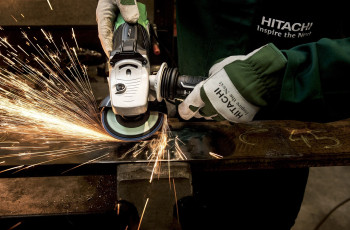In this article, you will discover the fascinating world of innovative materials and coatings that are revolutionizing heavy-duty die grinder components. From cutting-edge polymers to advanced ceramic coatings, these advancements are enhancing the durability, efficiency, and performance of these essential tools. By exploring the latest advancements in materials and coatings, you will gain valuable insights into how these technologies are shaping the future of die grinder components and ultimately, improving the overall user experience. So, let’s embark on this exciting journey and uncover the groundbreaking possibilities in this realm of industrial innovation.
Introduction
In today’s world, innovation plays a crucial role in driving progress and efficiency across various industries. One area where innovation is particularly important is in the development of materials and coatings. These advancements have the potential to greatly enhance the performance, lifespan, and efficiency of heavy-duty die grinder components. By exploring the importance of innovative materials and coatings, the types available, recent advancements, benefits, applications, challenges, and future trends, we can understand the significant impact they can have on the industry.
Importance of Innovative Materials and Coatings
Enhanced Performance
Innovative materials and coatings can significantly enhance the performance of heavy-duty die grinder components. By using advanced alloys and composites, these components can achieve higher strength, hardness, and durability. This allows them to withstand the rigorous demands of grinding operations, resulting in improved overall performance.
Extended Lifespan
Another crucial aspect of innovative materials and coatings is their ability to extend the lifespan of die grinder components. By using materials with superior resistance to wear, corrosion, and heat, these components can withstand continuous use without experiencing premature failure. This not only reduces downtime and maintenance costs but also increases the overall reliability of the equipment.
Improved Efficiency
Efficiency is a key factor in any industrial process, and innovative materials and coatings can greatly contribute to this aspect. With reduced friction and wear, these components can operate more smoothly, resulting in improved energy efficiency. Additionally, better heat and corrosion resistance can prevent the loss of performance due to overheating or chemical degradation, allowing the grinder to operate at optimal levels.

Types of Materials
Tool Steel
Tool steel is a popular choice for heavy-duty die grinder components due to its excellent strength, hardness, and wear resistance. It is commonly used for the construction of grinding wheels, shafts, and other critical parts. Tool steel can withstand high temperatures and intense pressures, making it ideal for prolonged and demanding grinding operations.
Carbide
Carbide is another widely used material in die grinder components. It is known for its exceptional hardness, which provides excellent resistance to wear and extends the lifespan of the components. Carbide tools are especially suitable for grinding applications that involve cutting hard materials, such as steel or concrete.
Ceramic
Ceramic materials offer unique advantages for die grinder components. They exhibit high heat resistance and chemical stability, making them suitable for high-speed grinding operations. Ceramic components also have excellent wear resistance and can maintain their shape and performance even under demanding conditions.
Diamond
Diamond is one of the hardest materials known to man and is often used as an abrasive in grinding applications. Diamond-coated components have exceptional wear resistance and can achieve high precision and surface quality. However, the use of diamond in die grinder components is relatively limited due to its high cost.
Composite Materials
Composite materials combine the advantageous properties of different materials to create components with enhanced performance. For heavy-duty die grinder components, composite materials can offer a unique combination of strength, wear resistance, and lightweight characteristics. This allows for improved performance without sacrificing durability or efficiency.
Types of Coatings
Titanium Nitride
Titanium Nitride coating is commonly used in die grinder components due to its excellent hardness, wear resistance, and low friction properties. It provides a protective layer that can significantly increase the lifespan of the components and reduce friction during grinding operations. Titanium Nitride-coated components are less prone to surface damage and can maintain their performance even under demanding conditions.
Diamond-like Carbon
Diamond-like Carbon (DLC) coating is a highly advanced and popular choice for die grinder components. It combines the exceptional hardness and wear resistance of diamond with the low friction properties of carbon. DLC-coated components can withstand high temperatures, resist chemical corrosion, and deliver superior performance over extended periods.
Ceramic Coatings
Ceramic coatings offer excellent heat resistance, corrosion resistance, and electrical insulation properties. They provide a protective layer that enhances the lifespan and performance of die grinder components. Ceramic-coated components can operate at higher temperatures, resist chemical degradation, and reduce friction, resulting in improved efficiency and durability.
Powder Coatings
Powder coatings are a versatile option for die grinder components, offering both protection and aesthetic appeal. These coatings are applied as a dry powder and then heated to create a durable and uniform finish. Powder coatings provide excellent resistance to impact, chemicals, and UV rays, while also improving the overall appearance of the components.
Fluoropolymer-based Coatings
Fluoropolymer-based coatings, such as PTFE, offer exceptional nonstick properties and chemical resistance. They are commonly used in die grinder components to reduce friction and prevent the buildup of debris during grinding operations. Fluoropolymer-coated components can operate without the need for lubrication, resulting in improved efficiency and reduced maintenance requirements.

Advancements in Material Science
Nanostructured Coatings
Nanostructured coatings involve the manipulation of materials at the nanoscale to enhance their properties. These coatings offer superior hardness, wear resistance, and durability compared to conventional coatings. Additionally, nanostructured coatings can provide tailored surface properties, such as reduced friction and improved adhesion, making them ideal for heavy-duty die grinder components.
Superhard Materials
Superhard materials, such as cubic boron nitride (CBN) and polycrystalline diamond (PCD), are gaining popularity in the field of die grinder components. These materials exhibit exceptional hardness, allowing them to withstand the most demanding grinding operations. Superhard materials offer improved wear resistance, extended lifespan, and superior surface finish.
Self-healing Materials
Self-healing materials have the ability to repair themselves when subjected to damage or wear. This innovative concept is being explored in the development of die grinder components to improve their durability and reliability. By incorporating materials with self-healing properties, the components can repair minor cracks or surface defects, preventing them from escalating into more significant issues.
Benefits of Innovative Materials and Coatings
Increased Durability
By utilizing innovative materials and coatings, heavy-duty die grinder components can achieve increased durability. These advancements provide higher resistance to wear, corrosion, and heat, allowing the components to withstand the harsh conditions of grinding operations. Increased durability translates to reduced maintenance, lower replacement costs, and improved overall reliability.
Reduced Friction and Wear
One of the key benefits of innovative materials and coatings is the reduction in friction and wear. By utilizing low-friction coatings and materials with high wear resistance, die grinder components can operate more smoothly and efficiently. Reduced friction minimizes heat generation and energy loss, resulting in improved performance and extended lifespan.
Enhanced Heat and Corrosion Resistance
Innovative materials and coatings offer enhanced heat and corrosion resistance, which is crucial for die grinder components. Heat resistance allows the components to operate at higher temperatures without compromising performance or safety. Corrosion resistance ensures that the components remain protected from chemical degradation, extending their lifespan and maintaining optimal functionality.

Applications of Innovative Materials and Coatings
Manufacturing Industry
The manufacturing industry extensively relies on heavy-duty die grinders for various processes, such as precision grinding, deburring, and surface finishing. By utilizing innovative materials and coatings, manufacturers can improve the performance, durability, and efficiency of their die grinder components, leading to enhanced overall productivity.
Aerospace Industry
The aerospace industry demands high precision and reliability in its grinding operations. Innovative materials and coatings offer the necessary strength, wear resistance, and durability required for critical components used in aircraft manufacturing. By incorporating these advancements, aerospace companies can achieve higher quality standards, improved safety, and reduced maintenance costs.
Automotive Industry
The automotive industry heavily relies on die grinders for the production of complex engine components, such as crankshafts and camshafts. Through the use of innovative materials and coatings, automotive manufacturers can enhance the performance, lifespan, and efficiency of these components. This leads to improved engine performance, reduced fuel consumption, and increased overall reliability.
Energy Sector
In the energy sector, heavy-duty die grinders are used for the production and maintenance of crucial components, such as turbine blades and pump impellers. By utilizing innovative materials and coatings, energy companies can ensure the reliability, efficiency, and longevity of these components. This results in improved energy production, reduced downtime, and lower maintenance costs.
Challenges and Limitations
Cost Implications
Innovative materials and coatings often come at a higher cost compared to traditional options. The development and production processes for these advancements involve advanced technologies and specialized equipment, increasing their overall price. Balancing the potential benefits with the associated costs can be a challenge for industries looking to adopt innovative materials and coatings.
Availability of Materials
Certain advanced materials used in innovative coatings may have limited availability. This can result in supply chain challenges, especially for industries with high demand for these materials. Striking a balance between material availability and the specific requirements of die grinder components can be a hurdle that industries have to overcome.
Compatibility with Existing Systems
Integrating innovative materials and coatings into existing die grinder systems can present compatibility challenges. This includes considerations such as fitting, structural integrity, and overall performance. Industries need to ensure seamless integration without compromising the existing functionality of their systems, which can require additional engineering efforts and testing.
Future Trends in Material and Coating Technologies
Nanotechnology Advancements
Continued advancements in nanotechnology will revolutionize the field of die grinder materials and coatings. Nanostructured materials and coatings will offer even greater control over properties such as hardness, friction, wear resistance, and self-healing capabilities. The use of nanomaterials will enable the development of components with unprecedented performance and longevity.
Multifunctional Coatings
The future of die grinder coatings lies in the development of multifunctional coatings. These coatings will not only provide protection and reduce friction but also possess additional functionalities such as self-cleaning or self-lubricating properties. By combining multiple benefits into a single coating, die grinder components will be able to achieve enhanced efficiency and reduced maintenance requirements.
Bio-inspired Materials
Bio-inspired materials have shown great promise in various industries, including the development of die grinder components. These materials draw inspiration from natural structures and processes to create innovative solutions. For example, mimicking the self-sharpening ability of shark teeth or the structural strength of spider silk can lead to the development of highly effective and efficient die grinder components.
Conclusion
Innovative materials and coatings hold tremendous potential for enhancing the performance, lifespan, and efficiency of heavy-duty die grinder components. By utilizing advanced materials such as tool steel, carbide, ceramic, diamond, and composite materials, industries can achieve increased durability, reduced friction and wear, and enhanced heat and corrosion resistance. Various coatings, such as titanium nitride, diamond-like carbon, ceramic, powder coatings, and fluoropolymer-based coatings, provide additional protection and functional benefits. Advancements in material science, including nanostructured coatings, superhard materials, and self-healing materials, further contribute to the improvement of die grinder components. This translates into several benefits for industries, including increased productivity, improved quality standards, reduced maintenance costs, and enhanced overall reliability. However, challenges and limitations, such as cost implications, material availability, and compatibility with existing systems, need to be considered when adopting these advancements. Looking towards the future, nanotechnology advancements, multifunctional coatings, and bio-inspired materials hold the key to the next generation of die grinder components. With the continuous development of innovative materials and coatings, the possibilities for optimizing heavy-duty die grinding operations are endless.



